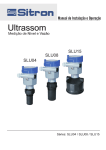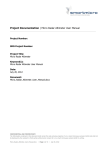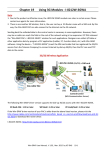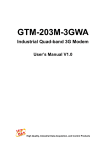Download WG8010 Cellular IP Modem User Guide
Transcript
WG8010 Cellular IP Modem User Guide WG8010 Cellular IP Modem User Guide Contact information, support For general contact, technical support, to report documentation errors and to order manuals visit: www.comway.com.cn Page 1 of 18 WG8010 Cellular IP Modem User Guide Document Information Revision Date Document History 1.0 20 MAY 2009 Initial Release GENERAL NOTE The aim of this document is to support the application and engineering efforts of COMWAY’s customers. This document is intended for testing, evaluation, integration, and information purposes. COMWAY makes every effort to ensure that the quality of the information is available. The content of this documentation is provided on an “as is” basis and may contain deficiencies or inadequacies. COMWAY disclaims any warranty and all responsibility for the application of the device(s) that is made in relation to the accuracy, reliability or contents of this document. COMWAY is not liable for any injury, loss or damage of any kind incurred for the use of or reliance upon information. COMWAY reserves the right to make any modifications, additions and deletions to this document due to typographical errors, inaccurate information, or improvements to products at any time and without notice. Page 2 of 18 WG8010 Cellular IP Modem User Guide Index 1. Introduction...........................................................................................................................4 1.1 Overview ...................................................................................................................4 1.2 Package Checklist ...................................................................................................4 1.3 Product Features .....................................................................................................4 1.4 Product Specifications.............................................................................................4 2. Getting Started ......................................................................................................................5 2.1 Panel layout ..............................................................................................................5 2.2 SIM Card Installation ...............................................................................................6 2.3 Connecting the Antenna .........................................................................................6 2.4 Connecting to a Serial Device................................................................................6 2.5 Connecting the Power.............................................................................................7 2.6 LED Indicators..........................................................................................................7 3. Pre-Deployment Considerations ...........................................................................................7 3.1 Cellular Network Connection .................................................................................7 3.2 Data Center IP address ..........................................................................................7 3.3 Operation Modes .....................................................................................................8 3.4 Transmission Protocol...........................................................................................10 4. Configure WG8010 with AT Command..............................................................................11 4.1 Determine which Com Port to Use......................................................................11 4.2 Start HyperTerminal ...............................................................................................11 4.3 Cellular Network Connection Configuration.......................................................13 5. Configure WG8010 with Configuration tools.....................................................................13 5.1 Serial Port Configuration.......................................................................................13 5.2 Cellular Network Connection ...............................................................................15 5.3 Flexible Connection ...............................................................................................16 5.4 Others ......................................................................................................................17 Page 3 of 18 WG8010 Cellular IP Modem User Guide 1. Introduction 1.1 Overview The WG8010 is a compact, stand-alone wireless IP (GSM/GPRS) modem, which can be used to connect any traditional serial (RS-232/485/422) device to a cellular network. The WG8010 IP Modem comes pre-installed with the TCP/IP protocol suite to transmit data back and forth between the serial device and GSM/GPRS network. Traditional SCADA and data collection systems rely on serial ports to collect data from various kinds of instruments, such as PLCs, meters, and sensors. Since the WG8010 IP Modem network-enables instruments equipped with an RS-232, or RS-485 communication port, SCADA and data collection system will be able to access all instruments connected to a standard TCP/IP network, regardless of whether the devices are used locally or at a remote site. The WG8010 IP Modem allows you to expand a serial port for a host computer on demand. As long as your host computer supports the TCP/IP protocol, you will not be limited by the host computer's bus limitation (such as ISA or PCI), nor will you be limited if you do not have drivers for various operating systems. 1.2 Package Checklist Each WG8010 IP Modem is shipped in a separate box with standard accessories. When you receive your shipment, please check the contents of the box carefully, and notify your COMWAY sales representative if any of the items are missing or appear to be damaged. WG8010 IP Modem is shipped with the following items: ·Document & Software CD. ·Rubber SMA Antenna. ·DC Power Supply. ·RS232 Serial Line. 1.3 Product Features ·Dual-band 900/1800 or 850 /1900 MHz GSM/GPRS ·Connects installed devices to Internet via serial port ·Adjustable baud rate feature for easy configuration of custom baud rates. ·Versatile operation modes, including Transparent, Transparent with Device ID, COMWAY Manage and Virtual COM ·Port buffering function to prevent loss of serial data when communication is disrupted. ·No Internet programming required ·Auto-registration on start-up ·LED indicators for status and signal level. 1.4 Product Specifications Cellular Interface Standards Band Options GPRS Multi-slot Class GSM/GPRS Dual-band 850/900 or 1800/1900 MHz Class 10 Page 4 of 18 WG8010 Cellular IP Modem User Guide GPRS Terminal Device Class Class B GPRS Coding Schemes CS1 to CS4 SIM Interface Number of SIMs SIM Control 1 1.8V, 3 V Serial Interface Number of Ports Serial Standards ESD Protection Power EFT/Surge Protection Serial Communication Parameters Baud rate Data Bits Stop Bits Parity Flow Control Operation Modes Transmission Protocol 1 RS-232/485/422 15 KV 2 KV 300 bps to 115.2 Kbps 5, 6, 7, 8 1, 1.5, 2 (when parity = None) None, Even, Odd, Space, Mark None Transparent, Transparent with Device ID, COMWAY Manage, Virtual COM TCP, UDP Physical Characteristics Weight Dimensions 130g 108 x 65 x 26 mm Environmental Limits Operating Temperature Operating Humidity Storage Temperature 0 -30 to 70 C 5 to 95% RH 0 -40 to 75 C Power Requirements Number of Power Inputs: Input Voltage 1 power jack 5 to 16 VDC Warranty Warranty Period 2 years 2. Getting Started This section describes how to connect the WG8010 IP Modem to a host PC or serial device for first time testing purposes. We cover topics such as: Wiring Requirements, SIM Installation, Connecting the Power, Connecting to a Serial Device, and LED Indicators. Note: Be sure to disconnect the power cord before installing and/or wiring your device. 2.1 Panel layout Page 5 of 18 WG8010 Cellular IP Modem User Guide 2.2 SIM Card Installation Insert SIM Card with the metallic part facing down and the clipped corner in the left. Note: Not to pull out the SIM holder without pushing the eject button 2.3 Connecting the Antenna The antenna is supplied with WG8010; connect it to the antenna connector on IP modem. 2.4 Connecting to a Serial Device The WG8010 support one RS-232 port that connects through a DB9 male connector on the bottom panel. Pin 1 Signal Pin 6 Page 6 of 18 Signal WG8010 Cellular IP Modem User Guide 2 RXD 7 3 4 5 TXD 8 9 GND 2.5 Connecting the Power Connect the 5 to 16 VDC power cord with the WG8010 IP Modem's power input. If the power is properly supplied, the "PWR" LED will glow a solid green color to indicate that the system is ready. 2.6 LED Indicators The LED indicators on the front panel of the WG8010 IP Modem are described in the following table. LED status Device Status DATA LED blinking PWR, LINK LED blinking PWR blinking LINK LED Permanently on Data transmission Not registered Net search Online 3. Pre-Deployment Considerations 3.1 Cellular Network Connection APN APN (Access Point Name) is the point where a mobile device can enter an IP network. Operator offers a public APN, letting all customers access the internet, and private APNs for direct access to a company LAN. Private APN settings can be customised to authenticate users and even to provide monitored internet access via the company’s web proxy. 3.2 Data Center IP address Public Fixed IP Address Mobile applications require a routable or “reachable” Data Center IP address. One way to accomplish this is with a public fixed IP address, which is generally reachable by anyone on the Internet. Dynamic Domain Name The demand for public IP addresses continues to grow, yet there are a finite number of public Page 7 of 18 WG8010 Cellular IP Modem User Guide IP addresses available. To solve this problem, wireless carriers have resorted to handing out dynamic IP addresses instead of static or fixed public addresses. With dynamic IP addresses, each device is given an IP address for a limited period of time (usually no more than a few hours), and then the IP address is changed. A Dynamic Domain Name Services (DDNS) server maps a static hostname to the remote device, so that no matter how often the IP address of that device changes, the hostname still points to the same device. 3.3 Operation Modes Transparent Mode A key feature of the WG8010 is a plug-and-play Transparent Operating Mode, which is perfect for retrofitting installed legacy devices with IP capability. Once the Transparent mode is established, the link becomes a pipeline for streaming raw serial data to WG8010. Data will continue to flow freely between the local and remote devices until a predefined activity occurs to terminate the remote connection. Transparent with Device ID Mode Device ID: User assigned ID number for the WG8010. If this parameter is enabled, every time when the socket is connected, WG8010 will immediately report its device ID COMWAY Manage Mode Before deploying wireless devices in the field, consideration must be taken on how those devices will be maintained and monitored. Sending technicians onsite to check status, or modify a device’s configuration can be both expensive and time consuming. COMWAY Manager is a server-based software toolset that eliminates these problems and provides the following features: • Ability to view all devices securely from anywhere • Batch configuration changes to one device or a thousand devices Virtual COM Mode In addition to providing socket access, this enables you to preserve your existing COM/TTY-based software without needing to invest in additional software. The WG8010 IP Modem comes bundled with COMWAY drivers for Windows systems; the bundled drivers are able to establish a transparent connection between a host and a serial device by mapping the serial port on the WG8010 IP Modem to a local COM port on the host computer. The WG8010 COM driver intercepts data sent to the host's COM port, packs it into a TCP/IP packet, and then redirects it to the Internet. At the other end of the connection, the Host accepts the IP frame from the cellular network unpacks the TCP/IP packet, and then transparently sends the data through the serial port to the attached serial device. Page 8 of 18 WG8010 Cellular IP Modem User Guide Defined form data package mode Under this mode, WG8010 sends three type data package to Data Center, registration package, data package, heart beat package. 1、 Registration package: This package are only sent after first time login into Data center Format: ID 4 byte PHONE_NUMBER 11 byte Description: ID: PHONE_NUMBER: IP_ADD: ETX: 0 IP_ADD ETX 1 byte 4 byte 1 byte ID, 8 bit HEX code Mobile phone number, 11 bit ASCII code Dynamic IP address, HEX code End of Registration package, 0x00 Example: 12 34 56 78 31 33 39 31 31 36 39 34 34 31 35 00 c0 a8 01 42 00 Explain: 12 34 56 78 ID: 0x12345678 31 33 39 31 31 36 39 34 34 31 35 Mobile Phone:13911694415 c0 a8 01 42 IP Address:192.168.1.66 2、Data package: Data to and from Data Center will be translated by following rules. ◆ To Data Center, all “0xfd” change to “0xfd 0xed” “0xfe change to “0xfd 0xee” ◆ From Data Center, all above change back ◆ The application on Data center should process data reversely 3、Heart beat package: WG8010 sends 1 byte length heart beat package “0xfe” periodically to keep connection alive. Page 9 of 18 WG8010 Cellular IP Modem User Guide 3.4 Transmission Protocol Data coming from a remote Device is packetized by the WG8010 and sends it via TCP or UDP to a remote host. The main difference between the TCP and UDP Socket protocols is that TCP guarantees delivery of data by requiring the recipient to send an acknowledgement to the sender. UDP does not require this type of verification, making it possible to offer faster delivery. TCP In TCP mode, the WG8010 IP Modem can actively establish a TCP connection to a pre-defined host computer when serial data arrives. As illustrated in the figure below, data transmission proceeds as follows: (1) The WG8010 IP Modem, requests a connection to the host. (2) Once the connection is established, data can be transmitted in both directions between the host and the WG8010. UDP Compared to TCP communication, UDP is faster and more efficient. In UDP mode, you can unicast to one or multicast to multiple serial devices. These traits make UDP mode especially well suited for message display Applications. Page 10 of 18 WG8010 Cellular IP Modem User Guide 4. Configure WG8010 with AT Command 4.1 Determine which Com Port to Use Step 1. On older computers, there is usually a built in Com port. This is normally Com1. Step 2. If you are using a USB-to-serial converter, you will need to determine which Com port it is installed on. Note: If the USB-to-serial converter has not been installed, install the necessary drivers per the instruction supplied by your USB-to-Serial device. Then leave the device unplugged. Step 3. Open up the System Properties window. This is done through the Control Panel → System or right-click on My Computer and select Properties. Select the Hardware Tab. Step 4. Select the Device Manager button. Expand the Ports section by selecting the + sign beside Step 5. Plug in the USB-to-Serial converter. The window should change to show the USB-to-Serial converter installed. Step 6. Most devices will show the Com port next to the device name. Record this number. Note: Make sure there is no “!” or “X” next to the USB device. If you see an “!” or an “X,” the device is not properly installed and will not work. 4.2 Start HyperTerminal Step 1. Connect the WG8010 IP Modem to the PC COM port and run HyperTerminal software. From the Taskbar, click [Start], followed by “All Programs” →Accessories →Communications → “HyperTerminal”. Step 2. You will be prompted to enter a description for the new connection. Enter a name for the connection (e.g. “WG8010 IP Modem”) and click [OK] to continue. Step 3. In the “Connect to” dialog box, select the PC COM port number, which is connected to the modem, and click [OK] to continue. Page 11 of 18 WG8010 Cellular IP Modem User Guide Step 4. In the next prompted dialog box; enter the port settings which is configured in the modem click [OK] to continue. Step 5.The “Connected” text in HyperTerminal status bar indicates that the PC is ready to communicate with the modem. Perform a simple check on the connection between HyperTerminal and the modem: Enter AT<Enter> command. An OK response (displayed on HyperTerminal) indicates that the connection is Page 12 of 18 WG8010 Cellular IP Modem User Guide successfully established. 4.3 Cellular Network Connection Configuration Step 1.Configure serial port: AT^BAUD=9600 Step 2. Give the WG8010 a unique name: AT^ID=”WG8010_Test” Step 3. Connect to your provider’s network AT+CGDCONT=1,”IP”,”cmnet” // replace “cmnet” with your APN ATDT*9 Step 4. Configure the WG8010 to talk with a specific server: AT^SERVER=”test.COMWAY.com”:5656 Step 5. Setup transmission mode AT^PKMD=0 //transparent mode Step 6. Store the current configuration to memory: AT^SAVE 5. Configure WG8010 with Configuration tools WG8010 Configuration tool is a PC-based software tool for managing and configuring WG8010 IP modem. With a full graphics mode and Windows-based environment; even first time users will find it easy to learn how to use this new tool. WG8010 Configuration tool can be used to configure the general parameters, without the need to look up AT commands. 5.1 Serial Port Configuration The serial parameters for the each serial port on the WG8010 IP Modem should match the parameters used by the connected serial device. You may need to refer to your serial device's user's manual to determine the appropriate serial communication parameters. Page 13 of 18 WG8010 Cellular IP Modem User Guide Baud rate (default=115200 bps) This field configures the port's baud rate. Select one of the standard baud rates from the dropdown box. Data bits (default=8) This field configures the data bits parameter. Stop bits (default=1) This field configures the stop bits parameter. Parity (default=none) This field configures the parity parameter. Flow control (default=none) This field configures the flow control type. Page 14 of 18 WG8010 Cellular IP Modem User Guide 5.2 Cellular Network Connection APN: In order for your IP modem to connect to your provider’s network, you must tell the modem the Access Point Name (APN) to which it will connect. The APN is a server name that your account is setup on with your provider. You can setup it with AT Command, for example. AT+CGDCONT=1,”IP”,”cmnet” ATDT*9 Main Server IP Address or Domain Name: To connect to a host PC, the host PC must be configured with public fixed IP address or Domain Name, if it is using a dynamic public IP name. Port Number: Backup Server: 1 through 4 (default=1) Protocol: TCP, UDP Page 15 of 18 WG8010 Cellular IP Modem User Guide Phone number: Use this field to configure the number used to dial out. Operation Mode: Transparent, Transparent with Device ID, COMWAY Manage, Defined form data package 5.3 Flexible Connection The WG8010 IP Modem can be configured for one of four network connections: always-on, wake-up on ring, dial-on demand, or on schedule. Always on The always-on network connection automatically establishes a wireless data connection and allows for around the clock surveillance, monitoring or real-time data acquisition of any remote device. If the data link is dropped in the event of poor reception or a complete loss of service, it will automatically re-establish the data link Keep-alive message: Keep-alive period (default=15 minutes): A periodic “keep-alive” or heart-beat message is sent from the device to the server to update its current status. This small amount of traffic (typically about 160-170 bytes) will refresh the carrier’s inactivity timer, thus helping maintain the persistent wireless connection. The keep-alive period is by default 15 minutes, but can be changed according to need. Wake-up on ring Page 16 of 18 WG8010 Cellular IP Modem User Guide The configuration allows the modem to “wake up” and initiate a connection when it detects an incoming ring. For security reasons, you can setup the modem to wake up based on the caller ID. This configuration is ideal for reducing the costs associated with the WG8010 being online and available 24/7 Auth type (default=none): To allow Caller ID Authentication Caller ID (1 through 4): Phone number should be specified. If you don't use Caller ID authentication, the WG8010 IP Modem will allow all incoming short messages as serial data to be forwarded to its serial port. This includes system broadcasts and advertisements. Dial-on demand When configured for dial-on demand, the cellular modem only accesses the Internet when data is present. On schedule 5.4 Others Hardware Reset Threshold Hardware reset thresholds will proactively reset the IP modem if the device fails to connect for any reason. This adds an extra level of robustness to the connection attempts. By default, the mobile interface reset is set to 3 failed attempts. Save Configuration To save your submitted configuration changes to the WG8010 IP Modem's flash memory. Page 17 of 18 WG8010 Cellular IP Modem User Guide The configuration changes will be effective when the WG8010 is restarted. If you do not save your changes before restarting, they will be discarded. Configuration Import/Export The WG8010 IP Modem can share or back up its configuration by exporting all settings to a file. Remember to backup your configuration by exporting it to a file. Your configuration can be easily restored by importing the file to the WG8010. Page 18 of 18

























